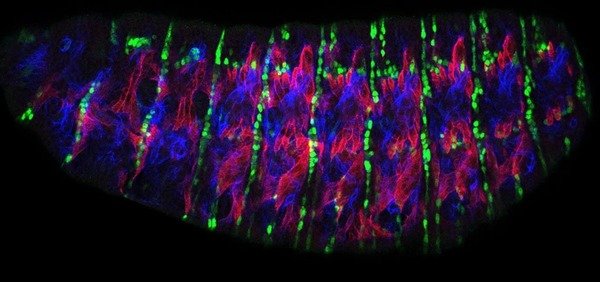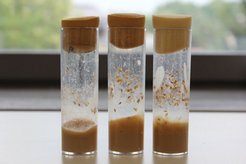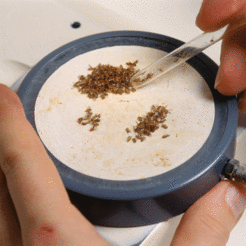
Fruit Flies: Husbandry and breeding
The life of a fruit fly consists of four phases: egg, larva, pupa and fully-formed fly. At 25 degrees, the fly embryo hatches one day after the egg is laid, and it then lives for five days as a larva. After three moults, the larva seeks a spot where it can be undisturbed and pupates. After a further four days, a fully-grown young fly emerges from the pupa.

Breeding tube for fruit flies: with different food variations, scientists can investigate how various types of fat affect the insulin levels of the animals.
As in other research facilities, too, the fruit flies live in precisely controlled conditions in climatic chambers in the Max Planck Society's animal holding units. For optimum growth, they need a temperature of 25 degrees, 65 percent humidity and a day/night cycle of twelve hours. The flies are kept in small plastic or glass containers which are closed by means of a gas permeable bung made of foam or cotton.
The bottom of the vessel is covered with food for the flies. Although they are termed "fruit flies", Drosophila does not feed on vegetable elements but on the yeast cells living on the fruit. The flies are therefore today given standardized blends of yeast and sugar in scientific holding units. Agar-agar is added as a gelling agent to give the food the right consistency. It has to be solid enough to ensure that the fully-grown flies do not stick to it but also soft enough to enable the larvae to eat it.
Depending on the temperature, the flies can live for several weeks in such culture vessels with no need to replenish the food supply. However, they are normally transferred to new vessels with fresh food after two to three weeks.

Researchers examine the insects in specially equipped fly laboratories. In order to analyze them, they anaesthetize them with carbon dioxide and sort them under a microscope by their sex or external characteristics. In addition, there are numerous tests with which scientists can observe the insects' fitness and behaviour.
One example is the so-called climbing test, which exploits the fact that flies usually walk in an upward direction. In this test, the flies are knocked to the bottom of the vessel. Scientists then measure how quickly they walk back up again. As their climbing speed decreases with age or in the event of dementia, this enables the effect of a drug or food component to be observed.
Safety
Although Drosophila is completely harmless to humans, animals and plants, no insects may be allowed to escape into the environment. This also applies because at most Max Planck Institutes, the research is conducted with genetically modified fruit flies. Such insects are subject to the safety provisions governing genetic engineering Safety Level 1. For that reason, there are safety provisions in place in the animal husbandry units that prevent flies from escaping. These include electric fly traps and fly-proof filters in front of the ventilation systems.

